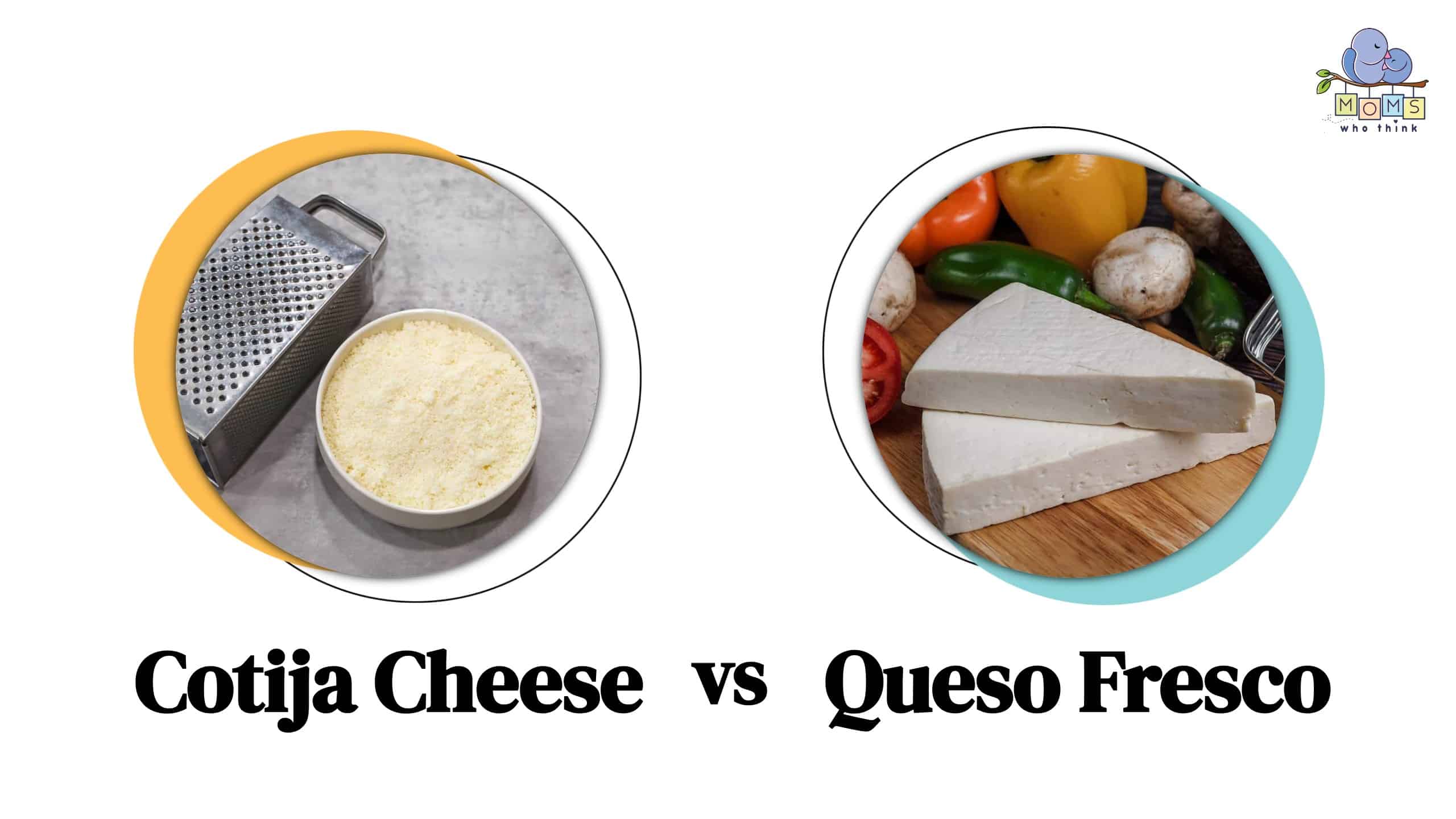Cheese is a significant ingredient in many dishes worldwide. A real cheese lover can identify some cheeses through appearance and taste. Italian cheeses like Cheddar, Parmesan, Raclette, and others are among the most popular in the market. However, Mexican cheeses, such as Cotija cheese and queso fresco, are coming up fast and are ideal toppings for some favorite Mexican dishes. Though they appear similar, they are quite different.
This post dives deeper into Cotija and queso fresco cheeses and explains their major differences, origin, texture, flavor, usage, and substitutes. Ultimately, you will be able to choose the best cheese, between the two, for your dish or correctly substitute one for the other.
Cotija Cheese vs. Queso Fresco: What Makes Them Different?
The primary difference between Cotija and queso fresco is the texture and taste. Cotija cheese is made from cow's milk and is hard and crumbly, while queso fresco is soft, moist, and made from cow or goat milk, or both. Their flavors vary because they are made from different ingredients. Cotija has a distinct salty taste, while queso fresco is milder and slightly tangy.
- The must-have convenient reference guide for every home cook!
- Includes more than 8,000 substitutions for ingredients, cookware, and techniques.
- Save time and money on by avoiding trips to grab that "missing" ingredient you don't really need.
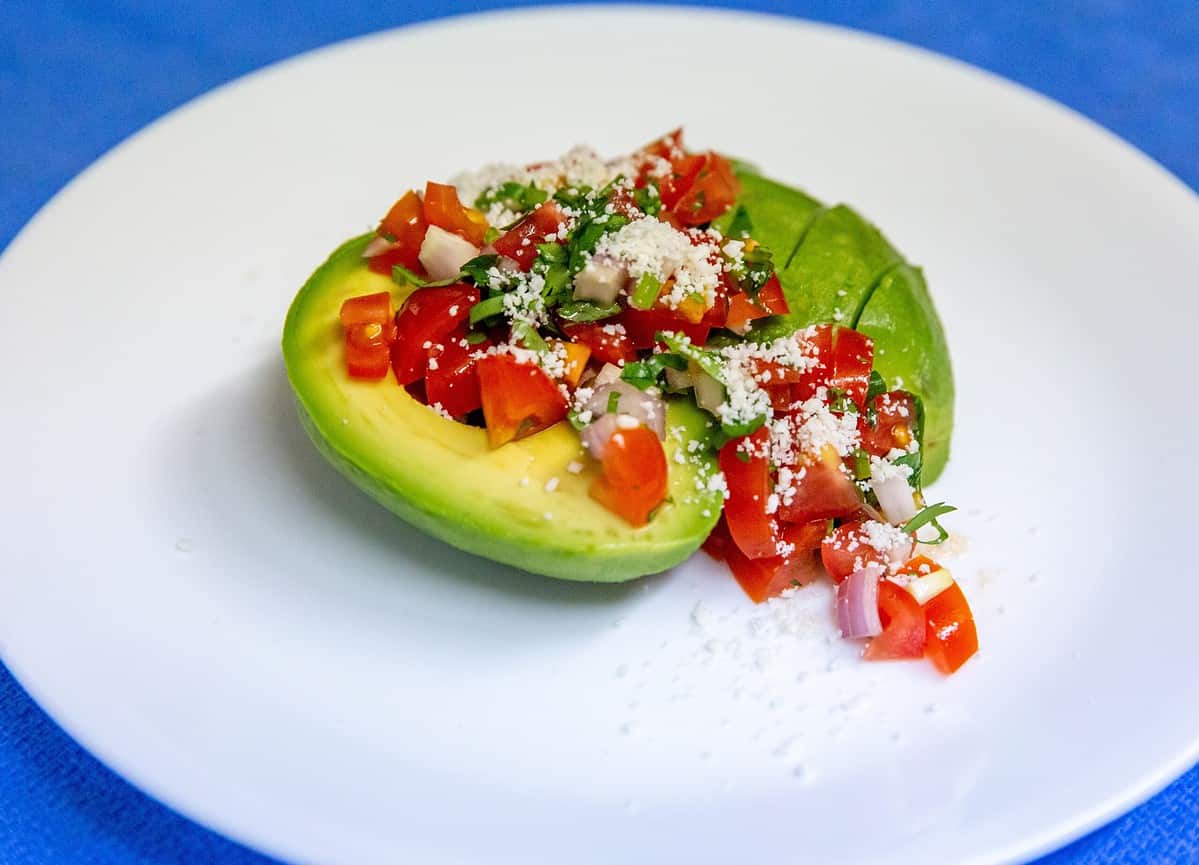
Fresh avocado with Cotija cheese makes a wonderful, filling snack.
©Lisa Top/Shutterstock.com
For this reason, Cotija cheese is best used for toppings and in small quantities to avoid overpowering the dish or masking other flavors. Queso can also work as a topping, but it's mostly for cooking and garnishing foods like empanadas and Rellenos. The mild tanginess and soft feel helps to add a beautiful and creamy texture to recipes. Unlike queso fresco cheese which is moist, Cotija is hard and dry. It makes it easier to grate or crumble into fine pieces, that's why it's ideal for sprinkling on dishes. Queso can also appear crumbly, but not as much as Cotija.
Another significant variation is the freshness or age of each cheese. When cheese stays longer without use, it becomes firm and harder with bold and rich flavors. Cotija usually has an age of 2 to 12 months, resulting in its compact texture, also known as a grating cheese. Queso fresco is fresh or unaged, hence its soft, moist, and slightly crumbly state. Also, Cotija has a longer shelf life than its queso fresco counterpart. When this cheese is fresh, it can last up to one month when refrigerated. As for the aged type, you can keep it refrigerated for as long as three months and still be in good condition. Queso fresco can last 3 days to a week maximum in the refrigerator before going bad, as it lacks any preservatives.
What is Cotija Cheese?
In simple terms, Cotija is a crumbly, hard white cheese made from cow's milk. The cheese has a unique name from a town in Mexico called Cotija. The townspeople first made Cotija cheese there, which is very popular in various dishes. It's one of the best toppings for nachos, enchiladas, Mexican street corn or elote, and other Mexican foods. Most of it is aged, anywhere between 2 to 3 months to a year, but in some instances, you can get it fresh. The longer the aging period takes, the more salty Cojita cheese becomes.
How Does Cotija Cheese Taste?
Anyone into cheese might have heard of the ‘Parmesan of Mexico.' The name may seem strange, but it is given to Cotija cheese based on its taste. Cotija cheese gets its salty or tangy flavor from aging. The flavor resembles the Italian Parmesan cheese though Cotija has a more intense flavor since it is more salty. Cotija cheese also has similar flavors to Greek feta cheese, Mexican aged cheese (queso anejo), Italian Ricotta Salata, and Pecorino Romano. You can tell how Cotija tastes by tasting any of the listed cheeses.
How to Make Cojita Cheese at Home
Here's an easy recipe for you to make this crumbly, salty cheese at home:
Ingredients:
- one gallon whole milk
- 1/4 teaspoon calcium chloride (optional)
- 1/4 tsp of mesophilic culture
- a quarter teaspoon of rennet
- 1/4 cup uniodized salt
Equipment:
- Thermometer with a large pot
- Cheese substance
- Colander
- Cheese mold (optional)
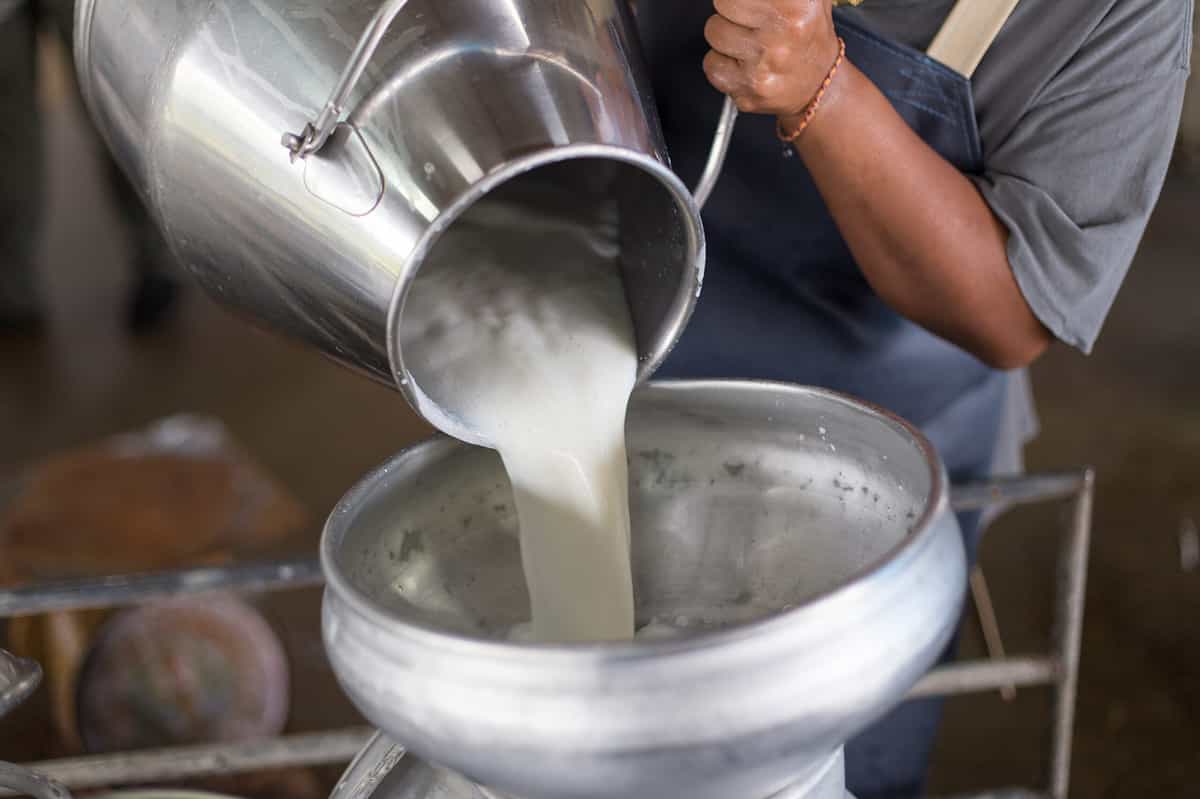
Both Cotija and queso fresco cheeses are easy to make and can be done at home by anyone!
©Rattiya Thongdumhyu/Shutterstock.com
Instructions:
- In a large pot, cook the milk over medium heat until it reaches 86°F. If you're using calcium chloride, mix it into the milk thoroughly.
- Add the culture to the milk and gently mix to incorporate.
- Add the rennet to the milk after diluting it in 1/4 cup of lukewarm, non-chlorinated water. For about 30 seconds, gently stir.
- Cover the kettle and leave the milk to stand for 45 minutes, or until the curds have formed.
- Cut the curds into small cubes with a knife. Allow the curds to settle to the bottom of the saucepan for about 10-15 minutes.
- Line a large bowl with a colander lined with cheese stuff. Transfer the curds to a colander using a slotted spoon. Allow the whey to drain for 1-2 hours.
- When the cheese has finished draining, sprinkle the salt over the curds and gently stir to combine.
- Transfer the curds to a cheese mold or shape them by hand into a ball or cylinder. If using a mold, push the cheese down to remove any air pockets.
- Allow the cheese to remain at room temperature for 24-48 hours, or until a dry rind has formed.
- Wrap the cheese in cheesecloth and place it in the refrigerator for at least 1 week before using. Cotija cheese can be stored in the refrigerator for several weeks.
- Crumble your homemade cotija cheese over salads, tacos, or enchiladas.
- Enjoy!
What is Queso Fresco?
Queso fresco is also a Mexican cheese made from raw goat or cow milk. Sometimes it's made by combining both types of milk to give it its flavor profile and characteristics. The name ‘queso fresco' is Spanish for ‘fresh cheese.' It refers to cheeses with less or no aging periods, mild taste, and semi-soft texture. The cheese has similar characteristics to the famous ricotta cheese. How they are made is almost very similar and later served fresh or after a few days of aging.
Being of Mexican origin, queso fresco is a great addition to the Mexican dishes. You can garnish by sprinkling on foods like tortillas, fried beans, black bean chiles rellenos as a filling, among other great ideas. Outside Mexico, this cheese is often used in Central and South America to prepare dishes like arepas, a Colombian dish.
How Does Queso Fresco Taste?
Queso fresco has a very mild taste since it's fresh and unaged. It lacks the tangy flavor of Cotija but is soft with a moisture-filled texture similar to Mozzarella cheese. It may look and taste like Mozzarella but note that it's not a melting cheese. For foods like quesadillas, use other cheeses to fill, then top with queso fresco. The milk used in production gives it a nice milky yet mild flavor that counters the spicy Mexican dishes to give a refreshing feel. The cheese's mild nature is similar to cheeses like Indian Paneer, Cottage cheese, farmer's cheese, or mild goat cheese.
Substituting Cotija Cheese and Queso Fresco
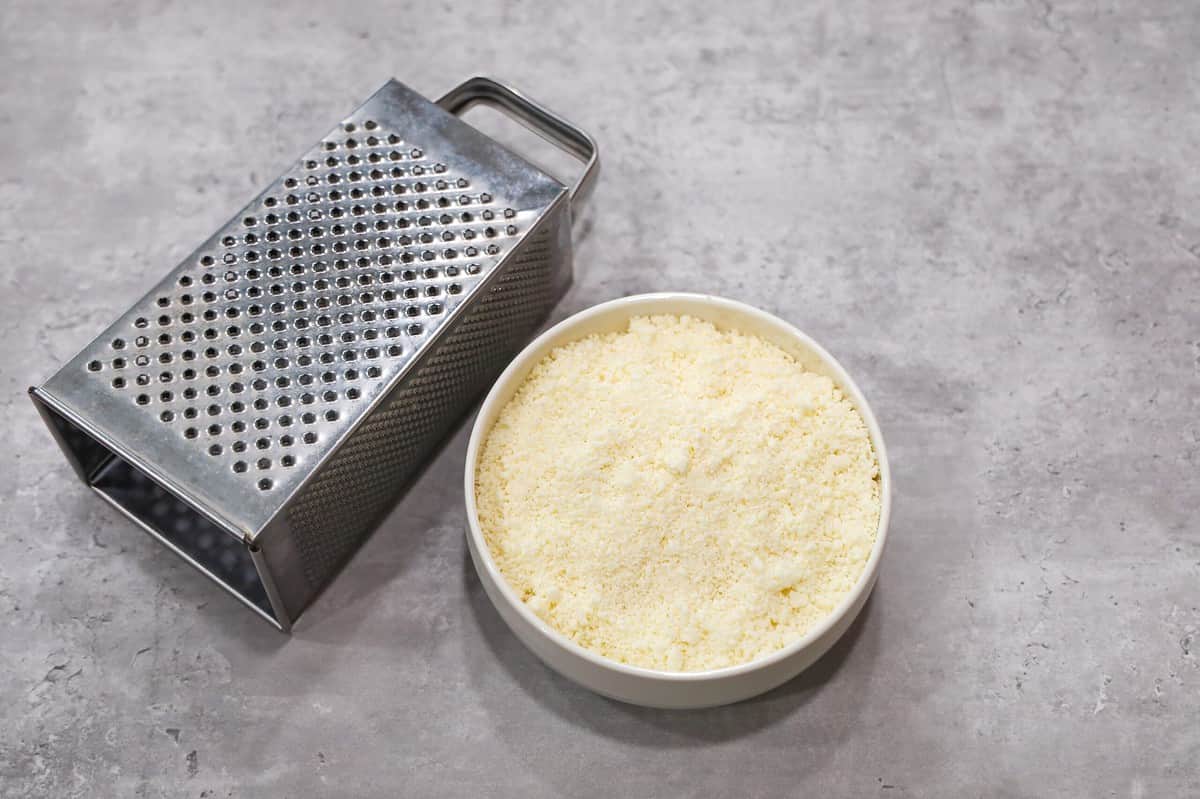
Top view of a bowl of Cotija cheese
©Rosamar/Shutterstock.com
Both kinds of cheese are great substitutes for each other. They are perfect for garnishing, finishing, or topping a range of savory foods, including tacos, burritos, enchiladas, and tostadas. These two kinds of cheese are white, milky, and crumbly, but remember how salty Cotija cheese is when making substitutions.
- The must-have convenient reference guide for every home cook!
- Includes more than 8,000 substitutions for ingredients, cookware, and techniques.
- Save time and money on by avoiding trips to grab that "missing" ingredient you don't really need.
If you are missing queso fresco cheese, replace it with Cotija but use it in small amounts. Being used to the mild queso flavor can make you hate Cojita cheese if you use too much of it! When using queso fresco instead of Cojita, use more of it to achieve a tangy or salty taste. Alternatively, add more salt to the cheese to get similar results. Both kinds of cheese are amazing if you adjust each accordingly to suit the recipe. Once you know how each cheese tastes and its characteristics, substitution becomes more manageable, and your Mexican dishes become amazing.
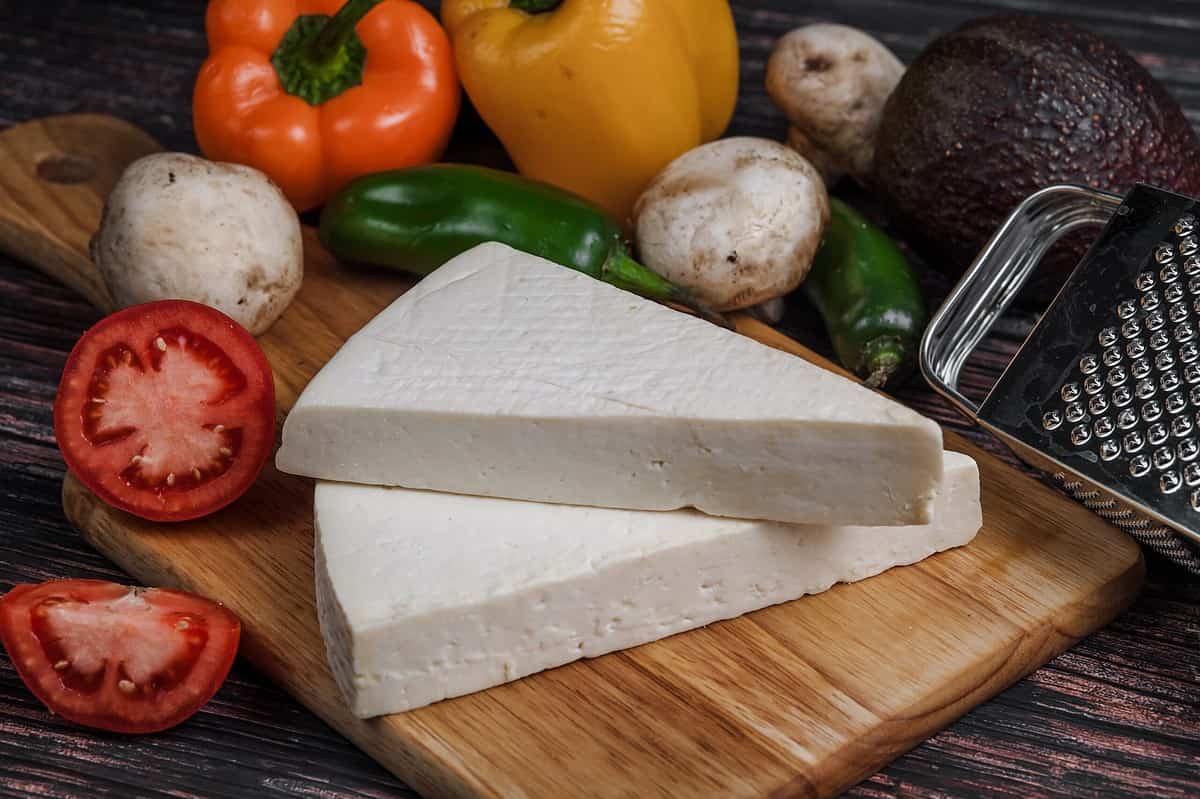
Queso fresco is a popular type of cheese with a mild taste and a semi-soft texture.
©Marcos Castillo/Shutterstock.com
How to Make Queso Fresco at Home
Here's a simple recipe for homemade queso fresco:
Ingredients:
- 1 gallon of milk (full or 2% fat)
- 1/4 cup lemon juice or white vinegar
- 1 tablespoon salt
Equipment
- Large pot
- Thermometer
- Cheesecloth
- Colander
Directions:
- In a large pot, cook the milk over medium-high heat until it reaches 185°F. Use a thermometer to check the temperature and stir the milk occasionally to prevent it from burning on the bottom.
- Remove from the heat and mix in the vinegar or lemon juice. The milk should immediately begin to curdle.
- Allow the mixture to sit for 10-15 minutes to allow the curds to completely separate from the whey.
- Place a colander lined with cheesecloth over a large bowl.
- Transfer the curds to the cheese fabric-lined colander using a slotted spoon. Allow the whey to drain for 30 minutes.
- Sprinkle the salt over the curds after half an hour and gently mix to combine.
- Gather the cheesecloth corners and bind them together to form a package deal. Hang the box over a basin or sink for another 1-2 hours, or until the cheese has reached the appropriate consistency.
- Unwrap the cheese from the cheese material and store it in an airtight field inside the refrigerator once it has done draining. Queso fresco can be stored for at least a week.
- Use your own queso fresco in your favorite dishes or as a topping for tacos, salads, and more!
Queso Fresco Recipes
Print
Pizza with Red Pepper Sauce
- Yield: 6 slices
Ingredients
Nonstick cooking spray
2 medium sweet red peppers
1 Anaheim pepper
1 tablespoon olive oil
1 clove garlic, cut up
½ teaspoon salt
½ teaspoon crushed cumin seeds
1 12-inch Italian bread shell
6 ounces coarsely shredded deli-roasted or rotisserie chicken (about 2 cups)
2 green onions, sliced
2 ounces crumbled or shredded queso fresco and/or Monterey Jack cheese (about ½ cup)
2 tablespoons dairy sour cream
¼ cup fresh cilantro leaves
1 small avocado, halved, seeded, peeled, and thinly sliced (optional)
1 serrano pepper or jalapeno pepper, thinly sliced (optional)
Instructions
1. Line a baking sheet with foil; lightly coat foil with nonstick cooking spray. Set baking sheet aside. Cut sweet peppers and Anaheim pepper in half lengthwise. Remove seeds and membranes. Place pepper halves cut side down on prepared baking sheet. Roast in a 425° oven for 20 minutes or until skins are blistered. Wrap pepper halves in foil; let stand for 10 minutes to steam. Peel and discard pepper skins. Coarsely chop peppers.
2. In a blender container or food processor bowl combine peppers, oil, garlic, salt, and cumin seeds. Cover and blend or process until smooth. (Store sauce in a covered container in the refrigerator for up to 10 days.)
3. Place bread shell on a preheated baking stone or 12-inch pizza pan. Spread with the red pepper sauce. Bake in the 425° oven for 5 minutes. Top with chicken, green onions, and cheese. Bake 5 minutes more. Top with sour cream, cilantro, and, if desired, avocado and sliced pepper.
Nutrition
- Serving Size: 1 slice
- Calories: 299
- Sodium: 642mg
- Fat: 9g
- Saturated Fat: 2g
- Carbohydrates: 38g
- Fiber: 1g
- Protein: 18g
- Cholesterol: 28mg
Cotija Recipes
Which Cheese is Better?
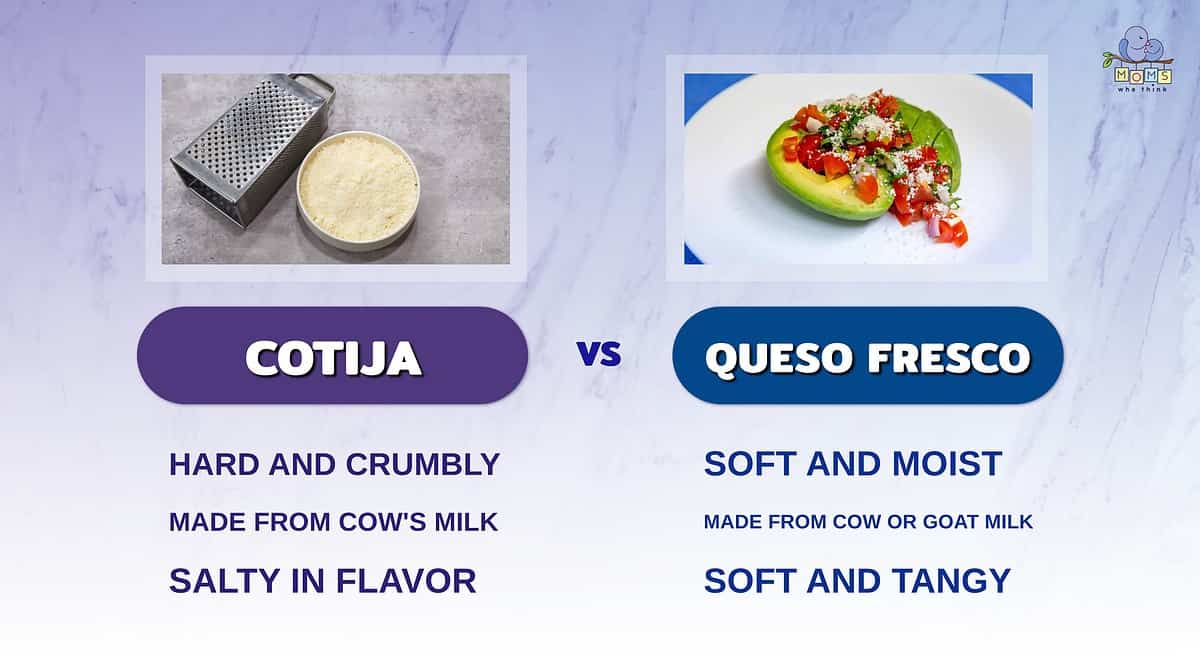
- The textures of cotija and queso fresco couldn't be more different. One is hard and crumbly, while the other is soft and moist.
- Cotija is made from cow's milk, while queso fresco is made from cow or goat milk. Sometimes, queso fresco can be made from a mixture of cow and goat milk.
- The flavor of cotija is salty, while queso fresco has a softer and tangy flavor. This makes these two cheeses suitable for different kinds of palates!
Ultimately, the best cheese for you is the one that you enjoy the most. If you are looking for a salty, tangy cheese, then Cotija is a good choice. If you prefer a mild, milky cheese, then queso fresco is a better option. Cotija and queso fresco are both delicious cheeses, so it really comes down to personal preference.
- The must-have convenient reference guide for every home cook!
- Includes more than 8,000 substitutions for ingredients, cookware, and techniques.
- Save time and money on by avoiding trips to grab that "missing" ingredient you don't really need.
